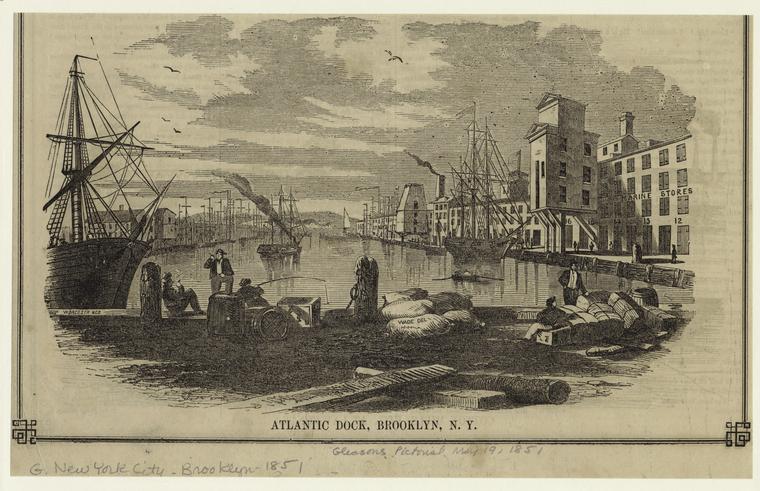Research at NYPL, Doc Chat
Doc Chat Episode Ten: Along Brooklyn's Industrial Waterfront
On November 12, 2020, Doc Chatters traveled back in time to take a virtual stroll along Brooklyn’s 19th-century industrial waterfront.
An ongoing series from NYPL's Center for Research in the Humanities, Doc Chat pairs a NYPL curator or specialist and a scholar to discuss evocative digitized items from the Library's collections and brainstorm innovative ways of teaching with them. In Episode Ten, NYPL curators Ian Fowler and Julie Golia analyzed maps, illustrations, and other primary sources from NYPL’s collections to look at the transformation of Brooklyn’s waterfront economy and built environment.
Doc Chat Episode 10: Along Brooklyn's Industrial Waterfront from The New York Public Library on Vimeo.
A transcript of this event is available here.
Below are some handy links to materials and sources suggested in the episode.
Episode Ten: Primary Sources
Ian and Julie analyzed the following maps:

This map was issued in a 1862 report from the New York State Commissioners of the Land Office that is also in NYPL’s Collection:
Report of the Commissioners of the Land Office relative to New York harbor encroachments, to Robert Campbell, president of the Senate, Jan. 9, 1862.


Episode 10: Reading and Resources
Robert G. Albion, The Rise of New York Port, 1815-1860 (Scribner, 1970).
Charles B. Barnes, The Longshoremen (Russell Sage Foundation, 1915).
Kevin Bone, ed., The New York Waterfront: Evolution and Building Culture of the Port and Harbor (Monacelli Press, 1997).
Joshua Brown and David Ment, Factories, Foundries, and Refineries: A History of Five Brooklyn Industries (Brooklyn Educational & Cultural Alliance, 1980).
Daniel Campo, The Accidental Playground: Brooklyn Waterfront Narratives of the Undesigned and Unplanned (Oxford University Press, 2013).
Brian Cudahy, Around Manhattan Island and Other Maritime Tales of New York (Fordham University Press, 1997).
William DiFazio, The Longshoremen: Community and Resistance on the Brooklyn Waterfront (Bergin & Garvey, 1985).
Marc Levinson, The Box: How the Shipping Container Made the World Smaller and the World Economy Bigger (Princeton University Press, 2008).
Ernest Poole, The Harbor (Grosset and Dunlap, 1915).
Malka Simon, “’The Walled City’: Industrial Flux in Red Hook, Brooklyn, 1840–1920.” Buildings & Landscapes: Journal of the Vernacular Architecture Forum Vol. 1, No. 2 (Fall 2010), 53-72. (accessible with a valid NYPL library card)
Ted Steinberg, Gotham Unbound: The Ecological History of Greater New York (Simon & Schuster, 2014).
Henry R. Stiles, A History of the City of Brooklyn including the Old Town and Village of Brooklyn, the Town of Bushwick, and the Village and City of Williamsburgh, three volumes (Brooklyn, 1870).
Waterfront, exhibition at the Center for Brooklyn History (formerly Brooklyn Historical Society).
Brooklyn Waterfront History, place-based digital exhibition from Brooklyn Bridge Park and the Center for Brooklyn History (formerly Brooklyn Historical Society).
Check out the following institutions committed to preserving the history and culture of Brooklyn’s waterfront.
Join the Doc Chat Conversation
Doc Chat's Fall season has wrapped! You can catch up on past episodes on the NYPL blog. We're busy planning an exciting Spring 2021 season, so make sure you don't miss an episode by signing up for NYPL's Research newsletter.
Read E-Books with SimplyE
 With your library card, it's easier than ever to choose from more than 300,000 e-books on SimplyE, The New York Public Library's free e-reader app. Gain access to digital resources for all ages, including e-books, audiobooks, databases, and more.
With your library card, it's easier than ever to choose from more than 300,000 e-books on SimplyE, The New York Public Library's free e-reader app. Gain access to digital resources for all ages, including e-books, audiobooks, databases, and more.
If you don’t have an NYPL library card, New York State residents can apply for a digital card online or through SimplyE (available on the App Store or Google Play).
Need more help? Read our guide to using SimplyE.
